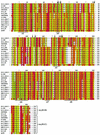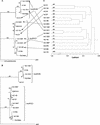Natural variation in the microcystin synthetase operon mcyABC and impact on microcystin production in Microcystis strains
- PMID: 12700256
- PMCID: PMC154389
- DOI: 10.1128/JB.185.9.2774-2785.2003
Natural variation in the microcystin synthetase operon mcyABC and impact on microcystin production in Microcystis strains
Abstract
Toxic Microcystis strains often produce several isoforms of the cyclic hepatotoxin microcystin, and more than 65 isoforms are known. This has been attributed to relaxed substrate specificity of the adenylation domain. Our results show that in addition to this, variability is also caused by genetic variation in the microcystin synthetase genes. Genetic characterization of a region of the adenylation domain in module mcyB1 resulted in identification of two groups of genetic variants in closely related Microcystis strains. Sequence analyses suggested that the genetic variation is due to recombination events between mcyB1 and the corresponding domains in mcyC. Each variant could be correlated to a particular microcystin isoform profile, as identified by matrix-assisted laser desorption ionization-time of flight mass spectrometry. Among the Microcystis species studied, we found 11 strains containing different variants of the mcyABC gene cluster and 7 strains lacking the genes. Furthermore, there is no concordance between the phylogenies generated with mcyB1, 16S ribosomal DNA, and DNA fingerprinting. Collectively, these results suggest that recombination between imperfect repeats, gene loss, and horizontal gene transfer can explain the distribution and variation within the mcyABC operon.
Figures







Similar articles
-
Recurrent adenylation domain replacement in the microcystin synthetase gene cluster.BMC Evol Biol. 2007 Oct 1;7:183. doi: 10.1186/1471-2148-7-183. BMC Evol Biol. 2007. PMID: 17908306 Free PMC article.
-
Detection of toxigenicity by a probe for the microcystin synthetase A gene (mcyA) of the cyanobacterial genus Microcystis: comparison of toxicities with 16S rRNA and phycocyanin operon (Phycocyanin Intergenic Spacer) phylogenies.Appl Environ Microbiol. 2001 Jun;67(6):2810-8. doi: 10.1128/AEM.67.6.2810-2818.2001. Appl Environ Microbiol. 2001. PMID: 11375198 Free PMC article.
-
The mosaic structure of the mcyABC operon in Microcystis.Microbiology (Reading). 2008 Jul;154(Pt 7):1886-1899. doi: 10.1099/mic.0.2007/015875-0. Microbiology (Reading). 2008. PMID: 18599818
-
Evidence for positive selection acting on microcystin synthetase adenylation domains in three cyanobacterial genera.BMC Evol Biol. 2008 Sep 22;8:256. doi: 10.1186/1471-2148-8-256. BMC Evol Biol. 2008. PMID: 18808704 Free PMC article.
-
Structural organization of microcystin biosynthesis in Microcystis aeruginosa PCC7806: an integrated peptide-polyketide synthetase system.Chem Biol. 2000 Oct;7(10):753-64. doi: 10.1016/s1074-5521(00)00021-1. Chem Biol. 2000. PMID: 11033079
Cited by
-
Duplex Real-Time Fluorescent Quantitative PCR Assays for the Detection of Toxigenic Microcystis Genotypes Based on SNP/InDel Variation in mcy Gene Cluster.Curr Microbiol. 2024 Jul 17;81(9):275. doi: 10.1007/s00284-024-03797-4. Curr Microbiol. 2024. PMID: 39020143
-
Evidence for recombination in the microcystin synthetase (mcy) genes of toxic cyanobacteria Microcystis spp.J Mol Evol. 2004 Jun;58(6):633-41. doi: 10.1007/s00239-004-2583-1. J Mol Evol. 2004. PMID: 15461420
-
Coherence of Microcystis species revealed through population genomics.ISME J. 2019 Dec;13(12):2887-2900. doi: 10.1038/s41396-019-0481-1. Epub 2019 Jul 30. ISME J. 2019. PMID: 31363173 Free PMC article.
-
Structural Diversity, Characterization and Toxicology of Microcystins.Toxins (Basel). 2019 Dec 7;11(12):714. doi: 10.3390/toxins11120714. Toxins (Basel). 2019. PMID: 31817927 Free PMC article. Review.
-
Characterization and Diversity of Microcystins Produced by Cyanobacteria from the Curonian Lagoon (SE Baltic Sea).Toxins (Basel). 2021 Nov 24;13(12):838. doi: 10.3390/toxins13120838. Toxins (Basel). 2021. PMID: 34941676 Free PMC article.
References
-
- An, J., and W. W. Carmichael. 1994. Use of a colorimetric protein phosphatase inhibition assay and enzyme linked immunosorbent assay for the study of microcystins and nodularins. Toxicon 32:1495-1507. - PubMed
-
- Arment, A. R., and W. W. Carmichael. 1996. Evidence that microcystin is a thio-template product. J. Phycol. 32:591-597.
-
- Asayama, M., M. Kabasawa, I. Takahashi, T. Aida, and M. Shirai. 1996. Highly repetitive sequences and characteristics of genomic DNA in unicellular cyanobacterial strains. FEMS Microbiol. Lett. 137:175-181. - PubMed
-
- Baker, J. A., B. A. Neilan, B. Entsch, and D. B. McKay. 2001. Identification of cyanobacteria and their toxigenicity in environmental samples by rapid molecular analysis. Environ. Toxicol. 16:472-482. - PubMed
-
- Beasley, V. R., W. O. Cook, A. M. Dahlem, S. B. Hooser, R. A. Lovell, and W. M. Valentine. 1989. Algae intoxication in livestock and waterfowl. Food Anim. Pract. 5:345-361. - PubMed
Publication types
MeSH terms
Substances
LinkOut - more resources
Full Text Sources
Other Literature Sources

